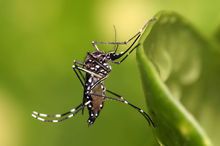According to the Equine Disease Communication Center, on July 10, 2015, two new cases of Eastern Equine Encephalitis were confirmed in Madison and Polk Counties, Florida. A one year old Arabian colt in Madison had only received one vaccine in his life while the 3 year old Quarter Horse mare had never been vaccinated.

Mosquito - Carrier of Eastern Equine Encephalitis virus
As in these two confirmed cases in Florida, Eastern Equine Encephalitis appears within five days after a mosquito transmits the virus to the horse, and the onset of clinical symptoms are abrupt with infected horses often dying or having to be euthanized within three days.
One horse was euthanized while the other died of natural causes. These are the first occurrences of Eastern Equine Encephalitis for Madison and Polk counties during the 2015 calendar year.
About Eastern Equine Encelphalitis
EEE virus attacks the central nervous system and unvaccinated horses are very susceptible to the infection. The disease appears within five days after a mosquito transmits the virus to the horse. Onset of clinical symptoms are abrupt and infected horses often die within three days.
Other diseases and poisoning may have similar symptoms. It is important that a speedy diagnosis is made. A veterinarian can take blood samples to send to a diagnostic laboratory.
EEE occurs in a wide variety of songbirds, including the blue jay, chickadee, cardinal, tufted titmouse and catbird. Mosquitoes that inhabit marshes and wooded wetlands, named Culiseta melanura,transmit the virus from bird to bird and also to horses and people.
Horses get Eastern Equine Encephalitis when they are bitten by a mosquito carrying the EEE virus.
Prevention
Annual vaccination of all horses and other equines is recommended. Horses vaccinated for the first time must receive an injection of EEE-WEE combined vaccine, followed by a second dose three to four weeks later.
The two-dose series is necessary to establish an effective immune response. If an outbreak occurs in the area, a second booster is advised.
Foals should be vaccinated at 4, 5, and 6 months of age for a total of three doses. Another booster should be given in six months and annually from then on.
In addition to making sure that all equines are vaccinated, horses should be taken in at times when the mosquito population is highest. This usually includes the hours around dawn and dusk. In some cases, horses can be blanketed or covered with protective gear to prevent bites. Insect repellant can be used on horses to prevent bites from mosquitoes.
In all cases, the population of mosquitoes should be controlled as much as possible by following the recommendations of mosquito-control personnel and the agencies in the area where horses are kept.
Any bodies of stagnant water should be drained and water-holding containers such as buckets, tires and other receptacles where water might accumulate should be emptied. Horse troughs and waterers should be flushed often to reduce mosquitoes near paddock areas.
Insecticides for treating mosquito nesting areas around homes and livestock premises should be used on a regular basis.
